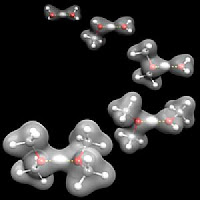 Shields For Starships: A Reality?
Shields For Starships: A Reality?To protect the occupants from the potentially lethal radiation in space from the Sun, a superconducting ring on board the space craft could produce a magnetic field, or mini-magnetosphere, similar to the Earth's, which would create a 'deflector or plasma shield'.
(Credit: Image courtesy of Royal Astronomical Society)
Cosmic rays and radiation from the Sun itself can cause acute radiation sickness in astronauts and even death. Between 1968 and 1973, the Apollo astronauts going to the moon were only in space for about 10 days at a time and were simply lucky not to have been in space during a major eruption on the sun that would have flooded their spacecraft with deadly radiation. In retrospect Neil Armstrong’s ‘one small step for Man’ would have looked very different if it had.
On the International Space Station there is a special thick-walled room to which the astronauts have had to retreat during times of increased solar radiation. However on longer missions the astronauts cannot live within shielded rooms, since such shielding would add significantly to the mass of the spacecraft, making them much more expensive and difficult to launch. It is also now known that the ‘drip-drip’ of even lower levels of radiation can be as dangerous as acute bursts from the sun.
On the surface of the Earth we are protected from radiation by the thick layers of the atmosphere. And the terrestrial magnetic field extends far into space, acting as a natural ‘force field’ to further protect our planet and deflecting the worst of the energetic particles from the Sun by creating a ‘plasma barrier’.
Now scientists at the Rutherford Appleton Laboratory in Oxfordshire plan to mimic nature. They will build a miniature magnetosphere in a laboratory to see if a deflector shield can be used to protect humans living on space craft and in bases on the Moon or Mars.
In order to work, an artificial mini-magnetosphere on a space craft will need to utilise many cutting edge technologies, such as superconductors and the magnetic confinement techniques used in nuclear fusion.
Thus science is following science fiction once again. The writers of Star Trek realised that any space craft containing humans would need protection from the hazardous effects of cosmic radiation. They envisioned a ‘deflector shield’ spreading out from the Starship Enterprise that the radiation would bounce off. These experiments will help to establish whether this idea could one day become a practical real.
_______________________________________________________
_______________________________________________________
Astronomers Map Out Planetary Danger Zone
Astronomers Make Detailed Image Of Giant Stellar Nursery
Hubble Space Telescope Reveals The Aftermath Of 'Star Wars'
_______________________________________________________
_______________________________________________________





